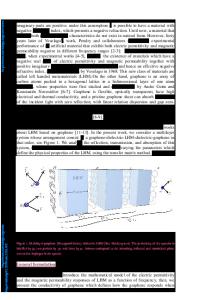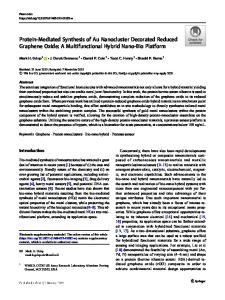One-pot electrosynthesis and physicochemical properties of multifunctional material based on graphene oxide, poly-o-phen
- PDF / 1,733,432 Bytes
- 10 Pages / 595.276 x 790.866 pts Page_size
- 6 Downloads / 901 Views
ORIGINAL PAPER
One-pot electrosynthesis and physicochemical properties of multifunctional material based on graphene oxide, poly-o-phenylenediamine, and silicotungstic acid E. Yu. Pisarevskaya 1
&
A. L. Klyuev 1 & A. A. Averin 1 & A. M. Gorbunov 1 & O. N. Efimov 2
Received: 16 August 2020 / Revised: 1 November 2020 / Accepted: 3 November 2020 # Springer-Verlag GmbH Germany, part of Springer Nature 2020
Abstract The methods of silicotungstic acid (SiW) immobilization on conducting substrates were studied. For SiW immobilization by codeposition, poly-o-phenylenediamine (PPD) redox polymer was used. The most effective codeposition of SiW and PPD was demonstrated on a graphene oxide (GO) film. Meanwhile, GO is reduced to form RGO-PPD-SiW electroactive composite. The structure of the novel material was evidenced by cyclic voltammetry and IR and Raman spectra. PPD-SiW and RGO-PPD-SiW composites were studied by impedance spectroscopy, where an equivalent circuit was proposed. Film resistance Rf was shown to decrease in the series of PPD → RGO-PPD → RGO-PPD-SiW. Further, RGO-PPD-SiW has better transfer properties (bulk film diffusion rate). This enabled suggesting that the composite has better electrocatalytic properties than PPD and RGO-PPD as was evidenced for example of [Fe(CN)6]4−/3− redox transfer on the electrode coated with the novel material. Keywords Silicotungstic acid . Graphene oxide . Poly-o-phenylenediamine . Modification
Introduction Due to their various properties, polynuclear metal oxide complexes (polyoxometalates or POMs) draw attention of experts in a wide range of sciences and applications. POMs are used in catalysts, photochemistry, material science, and medicine [1–3]. Heteropolyacids (HPAs) can be considered a POM subclass. For example, a silicotungstic acid (SiW)-based composite takes part in photocatalytic decomposition of methyl orange [4] and can be used for decomposition of some organic impurities to purify water. A range of POMs in nanomolar quantities can inhibit CK2 specific kinase protein, which enzyme is highly active in some cancer diseases [3]. The unique behavior of POM is its capacity of accepting up to 24 electrons
* E. Yu. Pisarevskaya [email protected] 1
A. N. Frumkin Institute of Physical Chemistry and Electrochemistry, Russian Academy of Sciences, Leninskiy Prospect, 31, Moscow, Russia 119071
2
Institute for Problems of Chemical Physics, Russian Academy of Sciences, 1 Acad. Semenov Ave., Chernogolovka, Moscow Region, Russia 142432
per one cluster [5]. Along with other properties, this determined numerous POM applications. It was especially interesting to use POMs as redox mediators (RМ), which take a key part in acceleration of electrochemical reactions [6], for example, in electrocatalysis, energy accumulation, and conversion systems (rechargeable batteries and supercapacitors), and in the sensors detecting biologically active substances. So a great attention is paid to both experimental and theoretical studies of RM influence to the electrochemical systems making
Data Loading...











